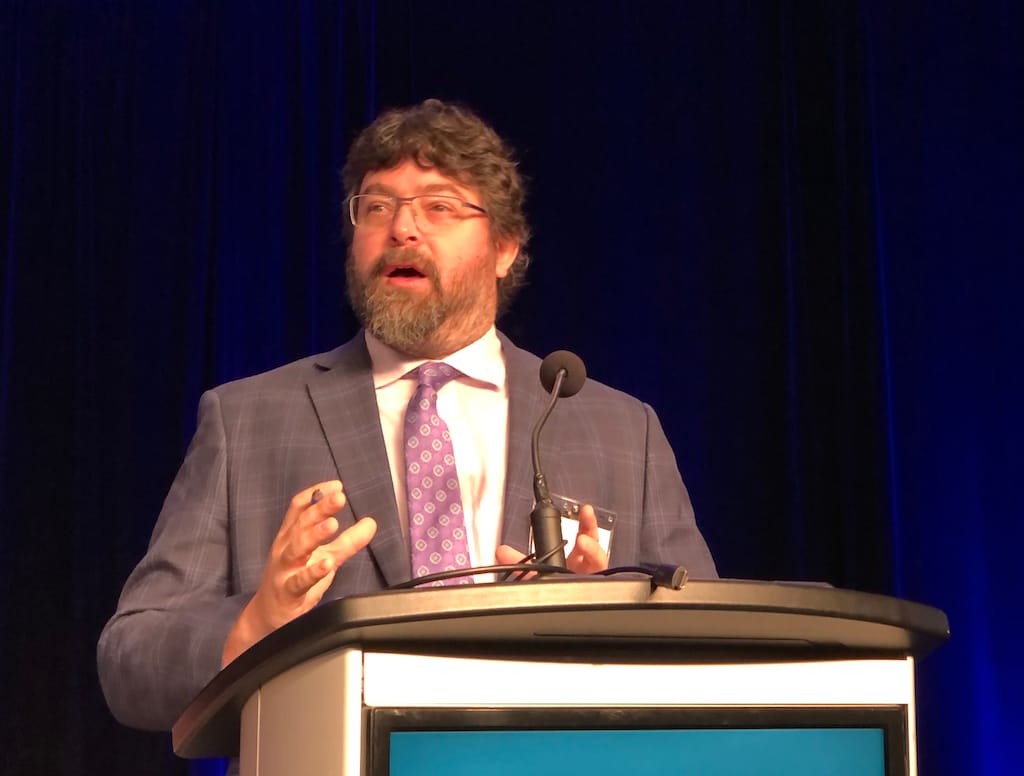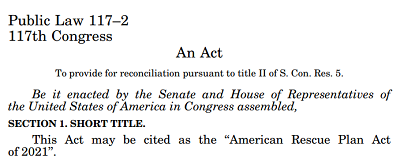Christopher Mitchell: Treasury Department Rescue Plan Act Rules Improve Broadband Funding
The Treasury Department has resolved all of the concerns that the Institute for Local Self Reliance identified in May.
Broadband Breakfast

Communities across the United States got an unexpected gift from the Biden Administration last week in the form of additional flexibility to use Rescue Plan funds for needed broadband investments, particularly those focused on low-income neighborhoods in urban areas.
When Congress developed and passed the American Rescue Plan Act, it tasked the Treasury Department with writing the rules for some key programs, including the State & Local Fiscal Recovery Funds (SLFRF). That program is distributing $350 billion to local and state governments, which can use it for a variety of purposes that include broadband infrastructure and digital inclusion efforts.
Treasury released an Interim Final Rule in May, 2021, detailing how local governments would be allowed to invest in broadband. I promptly freaked out, at the restrictions and complications that I (and others) feared would result in local governments backing away from needed broadband investments due to fears of being out of compliance with the rule.
After we worked with numerous local leaders and the National League of Cities to explain the problems we saw in the proposed rule, Treasury released updated guidance in the form of a Q&A document to explain how local governments would be able to build and partner for needed networks.
Given the many challenges the Biden Administration has had to deal with, we did not expect significant new changes to the Rescue Plan rules around the SLFRF. But after many months of deliberations, the Treasury Department has resolved all of the concerns that we identified as areas of concern in May.
As we explain below, local governments have wide latitude to use SLFRF funds for a variety of needed broadband infrastructure investments, especially to resolve affordability challenges.
Summary and TL;DR
The rest of this post will cover some key points in the Final Rule with references to the text in the hopes that it will help communities better understand their options and share key passages with their advisers and attorneys.
The SLFRF Final Rule weighs in at just under 500 pages and comes with an overview. The overview focuses on broadband on pages 39-40 and includes this summary toward the beginning:
Recipients may fund high-speed broadband infrastructure in areas of need that the recipient identifies, such as areas without access to adequate speeds, affordable options, or where connections are inconsistent or unreliable; completed projects must participate in a low-income subsidy program.
The relevant broadband infrastructure sections of the final rule are on pages 260-264 and 294-313. Pages 85-90 focus on digital inclusion, which is relevant and overlapping depending on community plans.
In general, the SLFRF has simplified the rules

to give more flexibility to state and local governments (across all of the eligible uses, not just broadband infrastructure). The original rule focused on areas lacking reliable 25/3 Mbps service – with a big focus on the word “reliable.” But there is no mention of 25/3 in the Final Rule.
Local governments do still have to make a determination that they are building the network to solve one of the problems that SLFRF uses as a trigger to allow broadband infrastructure investments, but they do not have to get approval from Treasury or any other entity. More detail below, but the triggers include lack of access to a reliable 100/100 connection or lack of access to affordable broadband service.
Any network built with SLFRF must be designed to deliver 100 Mbps download and upload, with the ability to do only 100/20 Mbps in some situations. That is the same as in the Interim Final Rule but now networks must also support the Affordable Connectivity Program (ACP) for as long as the program exists.
Qualifying to Use SLFRF for Broadband Infrastructure
Treasury set the tone for the revisions by noting on page 261:
- Treasury recognizes that there may be a need for improvements to broadband beyond those households and businesses with limited existing service as defined in the interim final rule.
This was a primary concern we heard from cities back in May – that the focus on served/unserved/underserved based on available broadband speeds did not adequately address the problems they faced, even with a strong caveat about reliability.
Cities may have 100 percent high-speed cable coverage but still have neighborhoods where many people are not able to access a broadband Internet connection due to challenges common to impoverished households. Treasury listened to these comments and adjusted the Rule (page 302 – emphasis added):
- The final rule expands eligible areas for investment by requiring recipients to invest in projects designed to provide service to households and businesses with an identified need for additional broadband infrastructure investment. Recipients have flexibility to identify a need for additional broadband infrastructure investment: examples of need include lack of access to a connection that reliably meets or exceeds symmetrical 100 Mbps download and upload speeds, lack of affordable access to broadband service, or lack of reliable broadband service. Recipients are encouraged to prioritize projects that are designed to provide service to locations not currently served by a wireline connection that reliably delivers at least 100 Mbps of download speed and 20 Mbps of upload speed, as many commenters indicated that those without such service constitute hard-to-reach areas in need of subsidized broadband deployment.
Local governments need to identify areas where at least some households lack high-speed services, or lack affordable access, or lack reliable broadband Internet service. As Treasury has made very clear, not every housing unit served by a network has to meet this condition (pages 302-303 emphasis added):
- Households and businesses with an identified need for additional broadband infrastructure investment do not have to be the only ones in the service area served by an eligible broadband infrastructure project. Indeed, serving these households and businesses may require a holistic approach that provides service to a wider area, for example, in order to make ongoing service of certain households or businesses within the service area economical.
We believe that a good source of data that can demonstrate an affordability or other problem that justifies broadband investment is where schools have sent mobile wireless hotspots home with students. This is a data set that nearly every school district should already have.
How to Prove an Area Qualifies
Even though local governments do not have to get approval for their determination that an area qualifies for this SLFRF expenditure, Treasury provides guidance for what evidence municipalities should consider in making the determination (page 303):
- Consistent with further guidance issued by Treasury, in determining areas for investment, recipients may choose to consider any available data, including but not limited to documentation of existing broadband internet service performance, federal and/or state collected broadband data, user speed test results, interviews with community members and business owners, reports from community organizations, and any other information they deem relevant.
And if that was not sufficiently clear, Treasury goes above and beyond to be very clear that cities should not be bullied by the occasional intimidating ISP or some other opponent of more broadband investment (page 303 still):
- In addition, recipients may consider the actual experience of current broadband customers when making their determinations; whether there is a provider serving the area that advertises or otherwise claims to offer broadband at a given speed is not dispositive.
This is a tremendously flexible framework. The federal government is giving local governments millions of dollars and trusting them to make wise investments that focus on the most vulnerable residents that are being left out of the opportunities the Internet offers. Some 17 states still limit local Internet choice by interfering with community authority to build a network or partner with an ISP. But everywhere else, communities have no one else to blame if they do not seize this historic opportunity.
Low-Cost Requirements and Encouraged Practices
Treasury adopted stronger requirements to ensure that the public dollars spent on these networks results in networks that are more accessible by all, including those living in poverty (page 308):
- In response to many commenters that highlighted the importance of affordability in providing meaningful access to necessary broadband infrastructure, the final rule provides additional requirements to address the affordability needs of low-income consumers in accessing broadband networks funded by SLFRF. Recipients must require the service provider for a completed broadband infrastructure investment project that provides service to households to:
- Participate in the Federal Communications Commission’s (FCC) Affordable Connectivity Program (ACP); or
- Otherwise provide access to a broad-based affordability program to low-income consumers in the proposed service area of the broadband infrastructure that provides benefits to households commensurate with those provided under the ACP.
Though it isn’t required, Treasury recognizes the importance of a low-cost, high-quality tier of service, and spells out key parts of it (page 309, emphasis added):
- Additionally, recipients are encouraged to require that services provided by a broadband infrastructure project include at least one low-cost option offered without data usage caps at speeds that are sufficient for a household with multiple users to simultaneously telework and engage in remote learning. Treasury will require recipients to report speed, pricing, and any data allowance information as part of their mandatory reporting to Treasury.
Other Bits of Interest
The Treasury Department uses OECD data as supporting evidence that the United States has a problem with affordable broadband Internet access on page 87:
- However, even in areas where broadband infrastructure exists, broadband access may be out of reach for millions of Americans because it is unaffordable, as the United States has some of the highest broadband prices in the Organisation for Economic Co-operation and Development (OECD).
Treasury urges these expenditures use fiber optic technology (pages 306-7):
- Treasury continues to encourage recipients to prioritize investments in fiber-optic infrastructure wherever feasible, as such advanced technology enables the next generation of application solutions for all communities and is capable of delivering superior, reliable performance and is generally most efficiently scalable to meet future needs.
As with every previous iteration of these rules, Treasury encourages prioritizing community networks – cooperatives, nonprofits, and local governments (page 298):
- Treasury continues to encourage recipients to prioritize support for broadband networks owned, operated by, or affiliated with local governments, nonprofits, and cooperatives.
Recipients of SLFRF funds have to report how they are using the funds. For broadband infrastructure expenditures, that reporting will include speed tiers, pricing, and data caps (page 309). Larger recipients report on a quarterly basis, smaller ones annually. More information on reporting guidelines here.
Additional discussion about the rule is available in the Q&A document, in this Beyond Telecom Law Blog, and CCG’s Pots and Pans.
Final note – I might be the only person who calls this the SLurF-uRF program but I encourage you to consider using that too because doing this work shouldn’t rob us of a juvenile sense of humor. Thanks for reading this far!
Editor’s Note: This piece was authored by Christopher Mitchell, director of the Institute for Local Self Reliance’s Community Broadband Network Initiative. His work focuses on helping communities ensure that the telecommunications networks upon which they depend are accountable to the community. He was honored as one of the 2012 Top 25 in Public Sector Technology by Government Technology, which honors the top “Doers, Drivers, and Dreamers” in the nation each year. This piece was originally published on MuniNetworks.org on January 13, 2022, and is reprinted with permission.
Broadband Breakfast accepts commentary from informed observers of the broadband scene. Please send pieces to commentary@breakfast.media. The views expressed in Expert Opinion pieces do not necessarily reflect the views of Broadband Breakfast and Breakfast Media LLC.










Member discussion